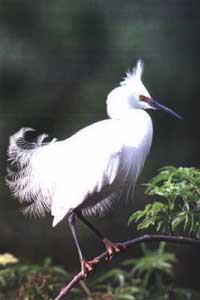|
The numbers are impressive, all the more so considering some of the tiny ambassadors behind them. In 2001, more than 3.2 million wildlife watchers spent as much as $1.6 billion on food, lodging and equipment in Florida to observe, feed and photograph wildlife, according to an economic analysis released this spring by the Florida Fish and Wildlife Conservation Commission. That's up to five times more than was spent at box offices nationally for Harry Potter and the Sorcerer's Stone, 2001's top-grossing film.
Birds are the big draw. Of the roughly 1.5 million people who left home to view wildlife, 85% devoted time to bird watching.

Although Florida wildlife watchers could fill Raymond James Stadium 43 times over, it's mostly an invisible sport. "People don't see other people doing it so they don't see the importance to the economy," says economist Rob Southwick of Southwick Associates, which conducted the analysis using data from the 2001 National Survey of Fishing, Hunting and Wildlife-Associated Recreation. The survey is conducted every five years by the U.S. Fish and Wildlife Service to track recreational trends and expenditures across the country.
What's most remarkable about these numbers, Southwick says, is that the survey counts only those trips where wildlife viewing was the main attraction. "People might be down at the Ritz Carlton in Naples and spend a day in the Corkscrew Swamp, but that person's not included." A native of St. Petersburg, Southwick grew up along Tampa Bay fishing and hunting, a fitting prelude to a career devoted to quantifying the economic impact of those activities.
Most of the action occurs close to home. About 2.6 million residents engaged in wildlife watching within a mile of their homes, many right in their backyards. Residents alone rang up more than $75 million in bird food purchases.
But wildlife also is doing its part to boost tourism coffers. More people traveled to Florida - 490,000 in 2001 - to view wildlife than any other state, pumping an estimated $400 million into the state economy.
Other comparisons are even more telling. Wildlife recreation expenditures for Florida in 2001 were:
- greater than all sales of camping equipment nationally ($1.37 billion), and about half as large as all golf equipment sales ($3.874 billion).
- twice as much as the value of the state's annual orange crop harvest ($786 million).
- five times greater than the tolls collected by the Florida Turnpike System ($311 million).
Figures like these are attracting the attention of tourism officials, hoping to cash in on nature-based tourism. Local marketing messages bear tell-tale signs of its influence. Pinellas County beckons visitors to "Discover Nature at Florida's Beach" with a glossy visitor's guide and website that touts the county's diverse natural amenities, from parks and preserves to the Pinellas Trail and the popular Florida Birding Festival that draws thousands of birders each year.
|
|
 "When you look at what our visitors are saying about the area, a clean, unspoiled environment is always #1," says Carole Ketterhagen, executive director of the St. Petersburg Clearwater Convention & Visitors Bureau. "When you look at what our visitors are saying about the area, a clean, unspoiled environment is always #1," says Carole Ketterhagen, executive director of the St. Petersburg Clearwater Convention & Visitors Bureau.
Nature is the main event at visitpasco.net, the county's online tourism portal, which serves up images of woodsy adventures and bird watchers enjoying endless trails.
"For those who think Florida is just beaches and amusement parks, a whole new adventure awaits in Pasco County," the site promises. But the ubiquitous tagline - a clear indication of the county's branding strategy - says it all: "It's only natural in Pasco County."

Photo courtesy of the Tampa Bay Estuary Program
Birds are a big attraction in Florida, which attracts more wildlife viewers than any other state.
"Nature-based tourism as a whole is huge," says Steve Hayes, executive vice president of the Tampa Bay Convention and Visitors Bureau. But the bureau's approach is to feature opportunities for natural experiences in Hillsborough County as part of a larger package of attractions and destinations.
Lowry Park and MOSI are excellent examples, he says, of ways to enhance the visitor experience with multiple options for learning and fun. Families visiting the zoo on the Hillsborough River can now experience nature in the wild on the zoo's new River Odyssey Ecotour. MOSI's Backwoods Adventures give students and other visitors a chance to explore natural habitats and learn about the plant and animal life inhabiting them.
Add to that the Florida Aquarium's Dolphin Quest Tour and Busch Gardens where visitors can explore the African Savannah after riding the roller coasters "and now I've got four major attractions with a combined attendance of three million people and all offering nature-based experiences," Hayes adds.
Hayes notes another interesting trend toward creating urban nature adventures. Guests at Tampa's swank Marriott Waterside Hotel can swap business gear for more casual attire and step out the back door for an off-pavement tour of downtown courtesy of Kayak Tampa Bay. For kayakers new and old, the urban estuary provides some fascinating vistas, from massive cruise ships to manatees lolling in the Hillsborough River, all within view of downtown skyscrapers.

|

